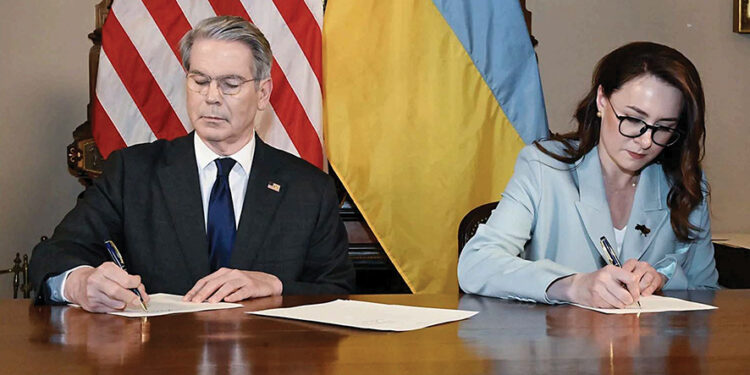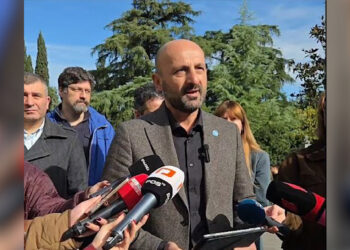Kyiv has signed a deal with the US to share profits from the future sale of Ukraine’s mineral and energy reserves, after months of tense negotiations.
The deal aims to provide an economic incentive for the US to continue to invest in Ukraine’s defense and reconstruction, as well as to address Washington’s concerns over the amount of aid it has already contributed.
Ukraine is believed to have vast reserves of critical minerals like graphite, titanium and lithium, which are highly sought after for use in renewable energy, military technology and infrastructure.
US Treasury Secretary Scott Bessent said the deal showed both sides were committed to lasting peace and prosperity in Ukraine.
The minerals deal will also see the establishment of an investment fund to spur Ukraine’s economic recovery from the war.
According to the statement from the US Treasury on Wednesday afternoon, the newly created US-Ukraine Reconstruction Investment Fund recognizes the “significant financial and material support” the US has given Ukraine since Russia invaded in February 2022.
The US Treasury secretary said in a video statement that the deal would help “unlock Ukraine’s growth assets.”
The language of the announcement shows much more solidarity with Ukraine than has thus far been seen from the Trump administration.
It refers to “Russia’s full scale invasion” and adds that “no state or person who financed or supplied the Russian war machine will be allowed to benefit from the reconstruction of Ukraine.”
The Kremlin has not yet responded to the agreement.
For Kyiv, it is seen as essential to accessing US military aid. Ukraine’s Deputy Prime Minister Yulia Svyrydenko, who flew to Washington to ink the deal on Wednesday, said in a post on X that the new fund would “attract global investment into our country.”
Listing the deal’s provisions, she said it would involve projects in minerals, oil and gas, although the resources would remain the property of Ukraine. The partnership will be equal, on a 50:50 basis, she added, and has yet to be ratified by lawmakers in Kyiv.
Under the deal, the US will contribute new assistance to Kyiv, including air defense systems.
President Donald Trump has repeatedly pushed for the agreement as a prerequisite to offering any future security guarantees to Kyiv. And while the draft of the deal indicates Ukraine will be giving Washington access to some of its natural resources in return for future US security assistance, it is significantly less than what Trump had wanted, which was to get paid back for all US military aid given since the start of the war.
Ukrainian President Volodymyr Zelensky has managed to eke out some concessions from Washington. The initial agreement was due to be signed in February, but fell apart following a heated exchange at the White House when Trump accused Zelensky of “gambling with World War Three.”
The breakthrough comes days after Trump and Zelensky held a face-to-face meeting on the sidelines of Pope Francis’ funeral, and as talks between Moscow and Washington over a possible ceasefire in Ukraine grind on.
Phoning into the NewsNation network on Wednesday evening, Trump said he had pressed Zelensky at the Vatican City to seal the deal.
“I was telling him that it’s a very good thing if we can produce a deal that you sign it,” he said, “because Russia is much bigger and much stronger. Russia is just chugging forward.”
The US president said the deal would recuperate the multi-billion dollar US assistance to Ukraine since the war began and “much more, in theory.”
“So I went to them and said, ‘Look, we got to get rare earth.’ They have great rare earth, meaning certain minerals, materials,” said Trump. “They have things that a lot of places don’t have. It’s a big asset that they have.”
The agreement comes amid a US trade war with China, where 90% of the world’s current rare-earth stocks are sourced.
Russia announces beginning of ‘direct talks’ with Ukraine
Russian President Vladimir Putin’s proposal for a ceasefire on Victory Day is the beginning of direct talks with Kyiv, Russian Foreign Minister Sergey Lavrov said on April 29 during a press briefing.
“Our proposal, which President Putin voiced, is the start of direct negotiations, without preconditions. In this situation, a ceasefire (for 30 days) is seen as a precondition,” Lavrov said.
It is not clear if Lavrov meant direct negotiations would begin at the time of the ceasefire, or if Putin’s announcement of it marked their commencement.
Ukrainian officials have not yet commented on Lavrov’s statement.
Putin claimed Russian forces would cease all hostilities from May 8 until midnight on May 11 to mark the 80th anniversary of the end of World War II in Europe.
Ukraine retorted by calling for a full and unconditional ceasefire, a proposal that Moscow continues to reject.
Fighting Updates
Russian drones attacked Ukraine’s Black Sea port of Odesa early on Thursday, killing at least two people and injuring five, the regional governor said. The attack sparked fires and damaged residential dwellings and infrastructure.
In Kharkiv, Ukraine’s second-largest city in the northeast, the mayor said another Russian drone had struck a petrol station in the city center, triggering a fire.
Ukraine’s SBU security agency claimed responsibility for a drone strike on a defense manufacturing facility in Russia. The strike on the Murom Instrument-Building Plant, 300km east of Moscow, sparked a fire and damaged two buildings.
Russian air defense units destroyed 34 Ukrainian drones overnight, Russian news agencies reported, citing the country’s Ministry of Defense.
Ukraine’s top military commander, Oleksandr Syrskii, said Russian forces have significantly increased the intensity of their combat activity in eastern Ukraine, despite Moscow declaring a three-day ceasefire from May 8-10.
Russian President Vladimir Putin said some small groups of Ukrainian soldiers were still holed up in basements and hideouts in Russia’s western Kursk region. Moscow claims it expelled Ukrainian forces from the border region over the weekend.
The Kremlin said at least 288 civilians were killed during Ukraine’s months-long incursion into Kursk.
South Korean lawmakers, citing their country’s intelligence agency, said about 600 North Korean troops have been killed fighting for Russia against Ukraine, out of a total deployment of 15,000.
United States lawmakers have asked the Department of State to brief them about Russia’s use of Chinese fighters in its war in Ukraine, saying that Moscow could only employ Chinese mercenaries with Beijing’s “tacit approval.”
Compiled by Ana Dumbadze














